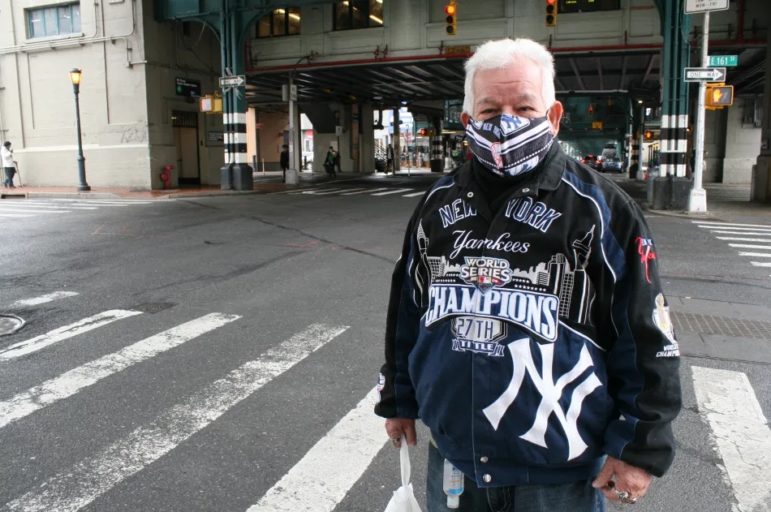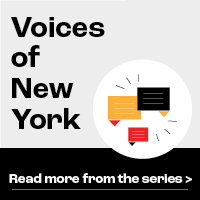‘For a whole year, this place has been like a graveyard,’ one Bronx worker told El Diario of the area around Yankee Stadium. The venue reopened to fans last week for the first time since the pandemic struck.

Fernando Martínez for El Diario
Fan and Bronx resident Luis Arzola was geared up to cheer for his team on opening day.This story was reported and originally published by El Diario on April 1, 2021. It was translated by Carlos Rodriguez, and has been lightly edited and condensed for clarity.
Puerto Rican-born Luis Arzola had his ticket to what he described as a “special event”: He was finally able to see and cheer his “great team” on in person. After nearly a year of closure due to the pandemic, on April 1 the legendary New York Yankees greeted fans at their Bronx home. Still, the stadium will operate at only 20 percent of its capacity, in compliance with the regulations imposed by New York’s health authorities.
“I have been coming to see my team for 50 years. I only missed last year because of the pandemic. I have been coming to the stadium since it was on the other side and you paid 50 cents to sit on some chairs outside. This is really exciting! Also, it is a sign that the city is coming back little by little after this virus tragedy. Here we are, getting back up,” said Arzola, who wore head-to-toe Bronx Bombers attire.
For the first time since the October 2019 American League Division Series playoffs, fans were able to return to Yankee Stadium for the first game of the season last week, where the home team faced the Toronto Blue Jays.
For Arzola and thousands of Bronx residents, the return of baseball this spring is a big step towards a “new normal.”
“You will have happier people, more people working. Businesses around here will be selling more and will be able to employ more people. That does not mean that the virus is gone—there is still a lot to deal with—but if we are careful and wear our masks, we might be able to return to our daily routines,” he said.
The return of one of the most emblematic sporting events of the Big Apple also signifies the first “inning” towards the economic revival of the area around the stadium, which has been hit hard by the lack of fans and tourists. The revered sports arena has been one of the main tourist attractions in New York City since 1923. For Bronx residents, the large, energetic commercial machine came to a halt last spring due to COVID-19.
“For a whole year, this place has been like a graveyard,” said an enthusiastic Víctor Manuel, from the Dominican Republic, who joined the other mostly Latino workers who carried out a deep sanitizing of the baseball field’s surroundings last week. The fact that the stadium is once again welcoming fans in person “is also a good sign that the economy will start moving again, that we will all have more jobs here in The Bronx. We are very happy,” he added.
The economic crisis in New York City is among the worst in the country, with unemployment rates averaging 13.2 percent, almost twice as much as the rest of the country. The Bronx has endured the worst economic devastation in the state during the pandemic, with the borough’s unemployment rate reaching 17.5 percent this past fall, compared to 10.3 percent in Manhattan.
For that reason, small businesses around the stadium are scrambling to survive. According to some of the area’s merchants, who rely on the masses who show up during baseball season for business, a season allowing a reduced audience capacity gives them “hope that we will be able to stay open,” said Hamal Kawn, manager of one of the Yankee memorabilia stores on 161st Street, a few blocks from the subway station. The thoroughfare has not seen its customary caravans of fans and visitors for months.
“We still need to be included in stimulus plans, because this type of merchandise does not provide large profit margins. We are betting on lifting New York City back up. We have not rested, [but] we still have a long way to normal. With so little attendance, movement will be slow, but it’s something,” said the merchant.
Pandemic safety protocols in New York State will only allow sports venues and outdoor events to operate at 20 percent of capacity. In the case of Yankee Stadium, which fits 54,250 people, this means that only 10,850 baseball fans will be able to attend.
The owner of a small restaurant in 161st Street’s commercial corridor, who chose to remain anonymous, said that he has applied for small business assistance through several city programs a number of times, to no avail.
“I did it twice following all the rules, but the system said that I do not qualify. I am months behind on rent at this location. Let’s hope that things move a bit more, now that the stadium is reopening,” he said.
However, as formal businesses such as restaurants and souvenir shops miss the crowds that New York’s favorite sport used to attract, people who used to sell goods informally are predicting another “dead season.”
Dominican immigrant Lucía Parada said she used to “get by” selling bottles of water before and after baseball games. She explained that, even though such sales are not allowed, “sometimes” the police would not bother merchants.
“Now, I doubt that they will even allow us to stand nearby, since they precisely do not want crowds because of the pandemic. We will see what happens,” said Parada, a resident of the area, in an optimistic tone. “Nothing is normal right now. And one has to understand that, if things are done the right way, we will go back to being the city we used to be faster.”










3 thoughts on “Bronx Latino Community Hopes Yankees Fans’ Return Will Herald Neighborhood’s Recovery”
The neighborhood and the businesses have been incredibly resilient.
Unfortunately, their efforts have not yet been matched by city or state support.
The corporate and foundation worlds have likewise been MIA for the South Bronx.
Hopefully, the spirit of cooperation and determination that has helped stores and families stay afloat until now will be matched by significant resources from elsewhere.
It’s going to be a tough year for the Yankees (and the Mets). All these endless Covid-19 restrictions are designed to discourage fans from going to the stadiums.
It’s not just the memoribilia stores and sports bars that have been affected.
A few blocks further east, some businesses that mostly catered to court staff and visitors have closed, since court proceedings are still limited and mostly virtual. The lunch hour on 161 is much quieter than in the past. On the other hand, it seems like more people from the neighborhood are out and about in the afternoon and early evening.